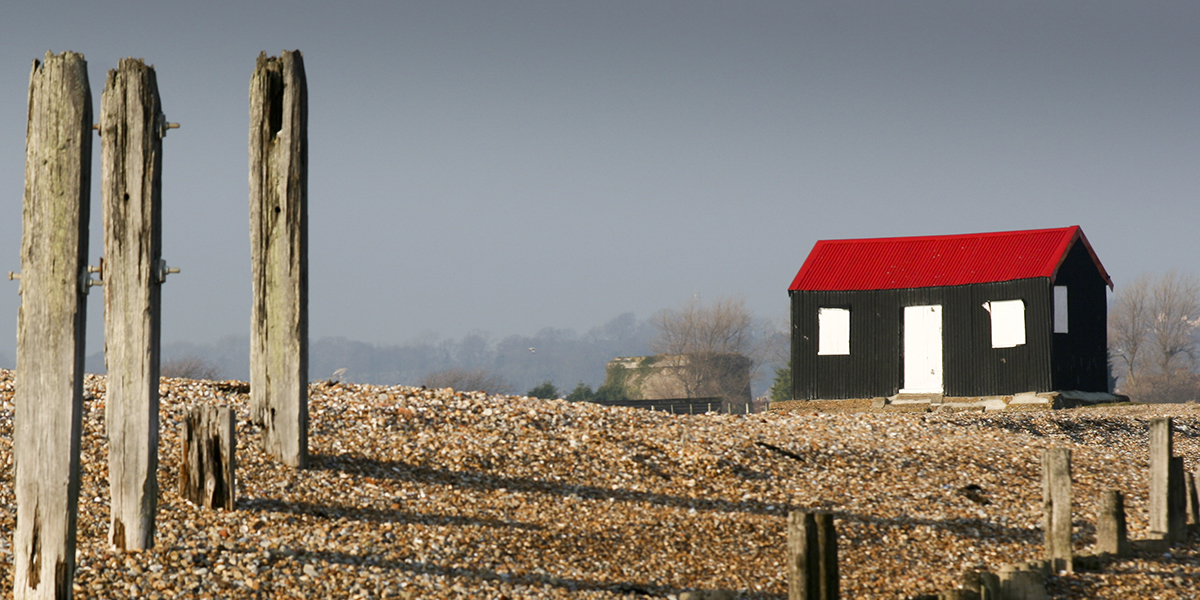Rye Harbour
A Poetry Trail
Words: Jane Lovell | Photographs: Barry Yates (Sussex Wildlife Trust)
Writer-in-residence, poet Jane Lovell, is creating a poetry trail at Rye Harbour Nature Reserve to encourage visitors to engage with the landscape and look for the often-overlooked details around them.
Imagine a town built on a shingle bank on the seaward edge of mudflats. People are wary of the sea but unprepared for the coming storms, storms that gradually worsen over decades, dismantling the town and submerging it foot by foot. The town was called Gwent-chesel-ey, 'Shingle Isle on the Level'. It was finally destroyed in 1287 by a ferocious storm, and the land on which it stood was claimed by the sea for the next 500 years. Today, people walk this land. They share the space with terns and gulls and curlews. Most have no idea what stood here all those centuries ago.
It's a warm and squally day with clouds barrelling in from the west. I park in Rye Harbour village and set off towards the Nature Reserve. Heavy rain is forecast and there is little shelter. Bordered on one side by the slow slide of the River Rother and on the other by the restless sea, its high points are ridges of shingle shelved by centuries of storm and tide; the low points are stretches of saltmarsh covering the sea-washed land between. With such wide, uncluttered horizons, you can see the weather coming from miles away. The landscapes here can seem almost transitory, built on reflections of saline lagoons and gravel pits caught by the changing light. If you don't mind facing the elements, it is wild and magical.
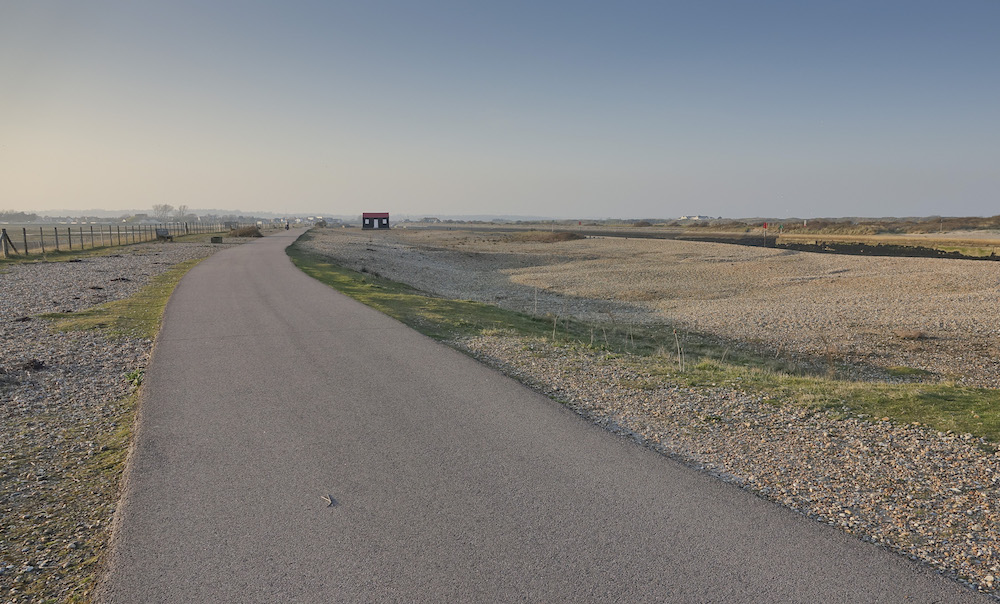
As the Nature Reserve's writer-in-residence, I'm hoping to create a poetry trail that encourages visitors to engage with this landscape, to listen, to take note of the detail; the transient skies, the resident birdlife and abundance of coastal plant life. I'm here to meet Dr. Barry Yates, the manager of the Reserve, to walk the trail and decide the places that offer the best visuals and soundscapes for poetry and contemplation. Barry has been managing Rye Harbour Nature Reserve for over thirty years. He knows every plant, every bird, the long term residents and the visitors, the rare and the prolific. He is passionate about the Reserve and proud of its development into one of Britain's most important wetland habitats.
We meet at the information cabins. The Reserve has over 360,000 visitors each year and a new Visitor Centre is currently being built on the site of the old Lime Kiln Cottage. The poetry trail will follow one of the established circular walks that begins at the cabins, tracks the estuary to the sea, skirts the shingle coast towards the west, and winds back through the grasslands and marshes past bird hides and gravel pits. There will be plenty to see and contemplate. Aside from the views, with such a variety of habitats, the Reserve forms a haven for thousands of species of wildlife.
Our first stop is an old stone block, halfway to the landmark red-roofed hut that has become a symbol of the Reserve. It is calm here but never quiet. A lark's winnowing song wheedles on a breeze fraught with the shrieks of black-headed gulls and haunting calls of oystercatchers. We are between two tides: the river behind us that carries boats to and from the Harbour and, in front of us, the tidal overspill that washes through the culvert into the salt water lagoons to the south and west. Beyond them, across this vast watery landscape, the dark line of the English Channel is just visible on the skyline.
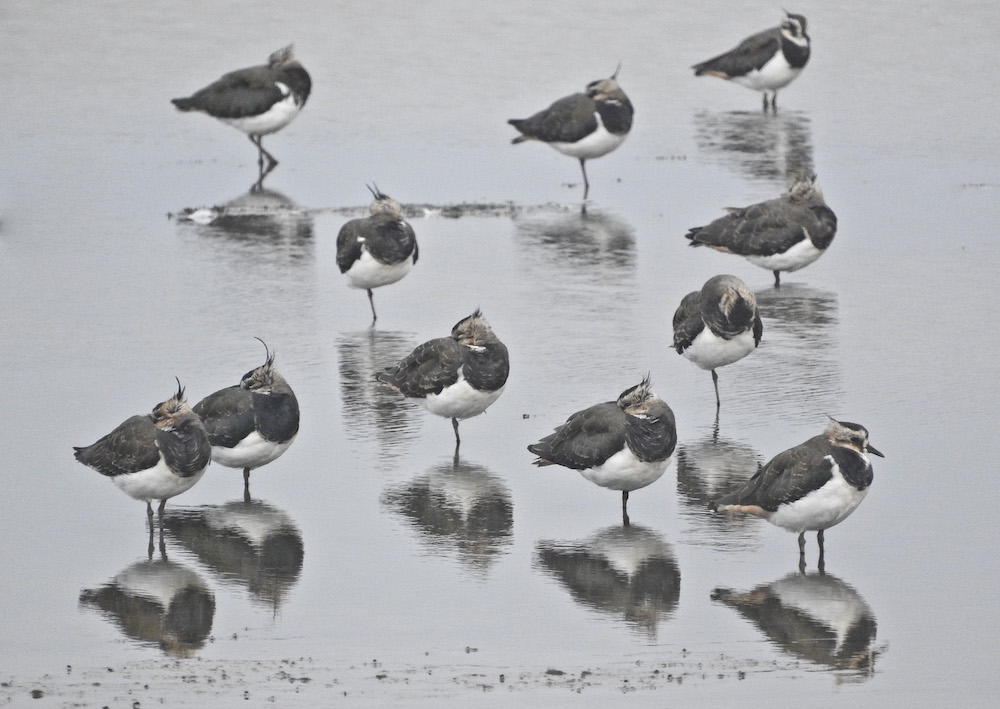
The sky today is burdened with cloud hanging darkly above the lagoons, thinning out to where the horizon skims the banked shingle - a photographer's dream. Look east and you can just make out the towers of Dungeness Power Station across Camber Sands. Look west and the cliffs of Fairlight rise from the brooding sea.
The beaches here are managed by recycling the shingle. For two months each winter, convoys of lorries tirelessly truck along the coastal track, returning it to the beaches at Pett. The road was only built in 1946. Before that, a narrow gauge railway was used to transport the shingle. Barry explains the roadway creates its own habitat. Three of the rarest plants in Britain are growing in the tract of land beside it: least lettuce, stinking hawksbeard, which was reintroduced after becoming extinct in the UK over 30 years ago, and the critically endangered red hemp nettle. All three are almost unnoticeable in the throng of coastal plants sprouting in a sea of shingle and sea kale.
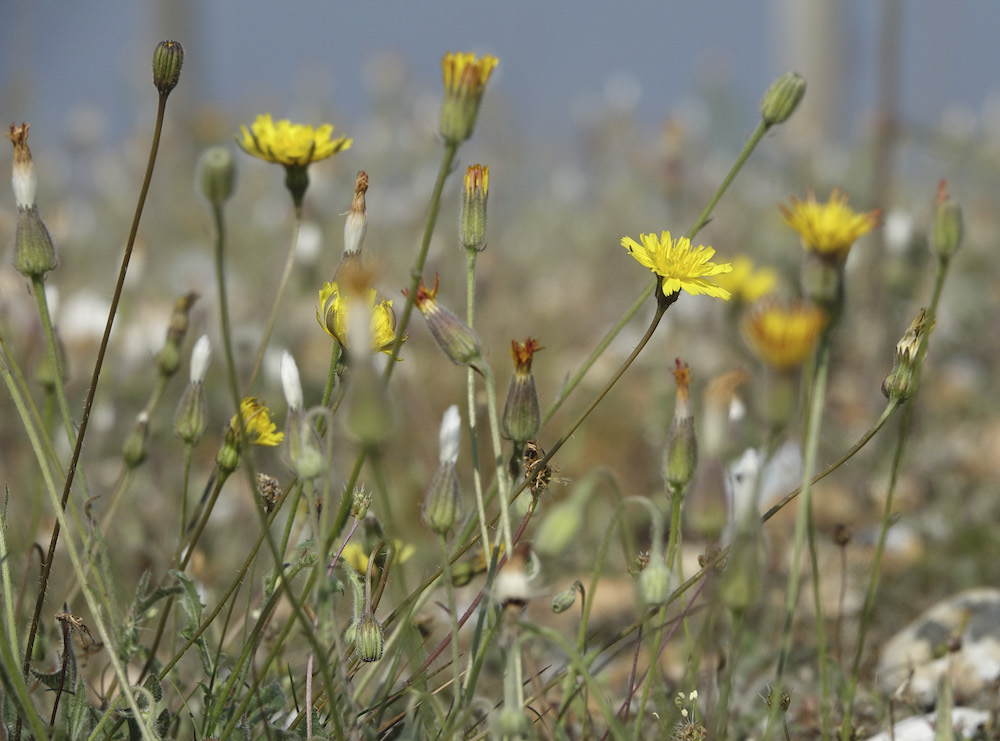
At the end of the coastal track, next to the WW2 pillbox, Barry looks back towards the sweep of reed beds, gravel pits and saline lagoons. "The river used to come out on the other side of Dungeness," he tells me, "and here, where we're standing, was the old town of Winchelsea. In fact, this land is less than 200 years old." There is a lot of history here, of changing coastlines and landscapes, and this particular stretch is a result of accumulating shingle at the mouth of the Rother.
Nothing remains of the original town of Winchelsea. Decades of wild weather and high tides in the second half of the 13th century resulted in the steady destruction of the shingle bank and, eventually, the town. A violent storm and tide surge resulted in its complete devastation in February 1287. The storm was so fierce that it ravaged the south east coast and altered the course of the Rother. The river no longer entered the sea near New Romney, but emerged fifteen miles away near Rye creating, in effect, the port of Rye. New Romney itself was inundated by shingle, mud and soil from Dungeness, completely filling the harbour and leaving the town nearly a mile from the sea.
Despite the flood defences, storms still have a significant effect on the landscapes and habitats at the Reserve. In December 2013, the sea wall was breached, flooding acres of land and washing away a section of the road between the cabins and the Gooders hide. Although devastating at the time, the flood resulted in significant quantities of shingle being relocated to form banks on the west side of the rebuilt road providing the protection for a new habitat.
As we follow the network of footpaths through the Reserve, Barry explains that the salt lagoons were created when a culvert was built, allowing tidal water from the estuary to flood out onto the marshy lowlands. It must be an amazing feeling, to have changed an entire landscape, I suggest. Barry is circumspect. "It's a mobile landscape; we're constraining it so that it can continue," he explains.
We take our time; there is much to see. He points out the coastal plants and how to recognise them. The names are fabulous: viper's bugloss, bristly oxtongue, ivy-leaved toadflax. Bedded in the shingle are crowns of yellow horned-poppies whose flowers only last a day before transforming into a long, curved seed pod and, hidden in the grasses, we find bee orchids with their extraordinary velvety flowers that mimic female bees.
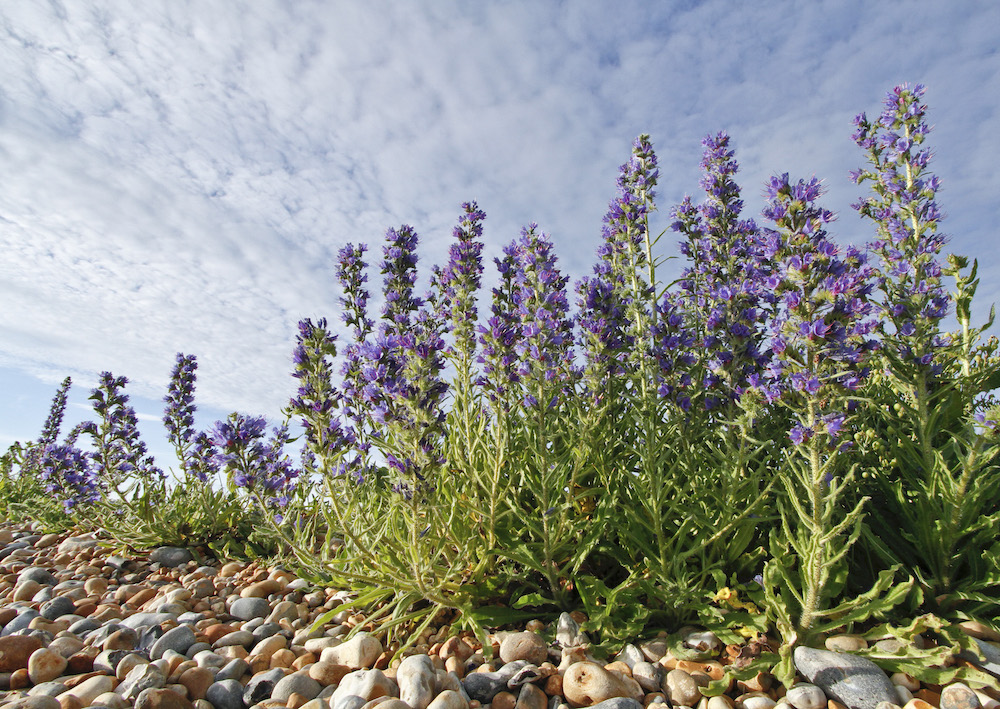
A little further along, a haze of waist-high yellow flowers borders the path. "Black mustard," he tells me. "It tastes really mustardy. But take care you don't eat the beetles." The plants are indeed infested with tiny black pollen beetles the size of fleas but, once these lodgers are shaken off, the flower-heads taste delicious, like peppery rocket. "I've had to cut them back," he explains, "they're taking over the paths." We step over their strewn cuttings.
Barry talks about the migratory birds you can see here each season. In winter, flocks of golden plovers and lapwing take over the meadows, wintering ducks such as teal and wigeon arrive. In summer, you have the avocets, goldfinches flitting between teasels, and the funereal silhouettes of cormorants on the islands.
I ask about the flock of Sandwich terns I had seen roosting on my last visit. 'They're nesting on an island in front of one of the hides," Barry tells me. "They found the courage, eventually, to settle." Sandwich terns are scarce breeding birds due to the scarcity of suitable safe nesting places along our crowded coast. Although their numbers have a degree of long-term stability, they are sufficiently erratic and unpredictable visitors to draw an audience in the hides when they arrive from wintering in Africa. They are sharply streamlined birds with great poise, but gathered here, even in the relative safety of a bustling colony, they are still at risk from predators.
From the Parkes Hide, a little further on, we watch them on the tiny salt lagoon island where they have decided to nest in the midst of a mob of black-headed gulls. It is crowded and there is little space, yet the terns somehow remain serene despite the gulls' scolding and squabbling. We spot the terns' chicks, mottled fluffy pebbles next to their pin-sharp black and white parents. The colony protects itself by cramming together in a small space and nesting close to a more aggressive species, but the larger predatory gulls are always at the edge of the picture, eyes pinned on any weak or sickly chick. The edges are the most dangerous: lapping water, shingle, a gull hovering. Only this week, one of the Reserve's keen photographers posted a picture on social media of a Mediterranean gull with the limp form of a tern chick in its beak. The herring gulls pose an even greater threat through their sheer numbers.
Barry is constantly trying to keep a balance between wildlife and wilderness, between a rogue sea and restless shingle, between predator and those seeking sanctuary. He tells me he was up at 4am, at the herring gulls' nesting site, replacing their eggs with plastic ones. The danger is that, if their numbers are allowed to escalate, they will have a profound effect on other species. There are further dangers to the nesting birds. "We've had foxes in," he says. "They can decimate the nesting population, and here, where waders come to breed, thistles and blackthorn have taken root. We need to get in and sort it out."
It is a endless fight to maintain equilibrium. Even the mildest weather takes it toll. Three hundred fence posts have had to be replaced this year. It's costly and time consuming. "Surely the foxes can leap these?" I ask as we stand against the wire fence looking out across pools where a lone avocet picks its way through the shallows. "Yes, but not the next line of defence," he says giving me a wry smile. "It's much higher and it has 5,000 volts running through it."
We complete our circuit of the Reserve and pause to listen to a flight of oystercatchers winging fretfully across the levels. The landscapes here, finely balanced on weather and tide, are always changing. You never experience the same scene from season to season, or from morning to evening, but after a time you find yourself in tune with the space, the vistas, the different light in hides that look east and west across the landscape, to the misted stretch of sands at Camber or, in the other direction, the lagoons, the old lifeboat shed and the cliffs rising above Pett Levels.
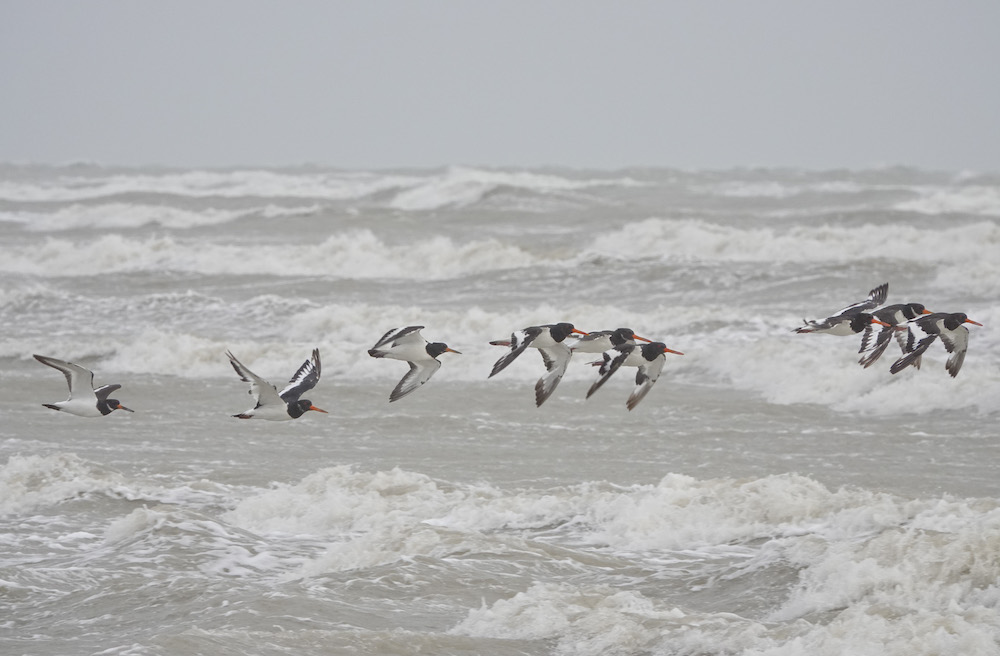
It's time to leave. I have all the information I need. This restless and unpredictable world is the perfect place to pause and contemplate.
On the way back, approaching the old site of Lime Kiln Cottage, I see a kestrel lift from the fence and ride the wind above the marsh, balancing with ease all the variables of light and movement and shadow in this windswept environment. Recent findings suggest that gravity is also a variable, minutely so, but possibly measured in 'zero-point fluctuations' by the kestrel who must calculate, amongst other things, the density of rock below the surface, the presence of nearby mountains.
There are no mountains here, but there is an endlessly shifting landscape for her to navigate. It is beautiful and wild and unpredictable, just like her. Before I leave, I write her down.
Kestrel
Above the ridge, a kestrel
rides the wind.
To unravel the trail of vole or shrew,
track its short light,
its quivering lungs,
she needs time and distance pinned.
She has learned:
adjust according to
latitude
altitude
the density of rock beneath
or the presence of nearby mountains.
I watch her calibrate the waves
measured in her eye, in the bones
of her skull, each riffled barb.
She holds the whole horizon
on the sway of invisible gimbals,
swing and hold
swing and hold
light and lens and intent
fixed
on the pulse of the smallest heart.
Jane Lovell is an award-winning poet whose work focuses on our relationship with the planet and its wildlife. Her latest collection This Tilting Earth is published by Seren. Jane's work has been published in Elementum Journal and she also writes for Dark Mountain and Photographers Against Wildlife Crime. She is Writer-in-Residence at Rye Harbour Nature Reserve and runs the Mid Kent Stanza group for the Poetry Society.
